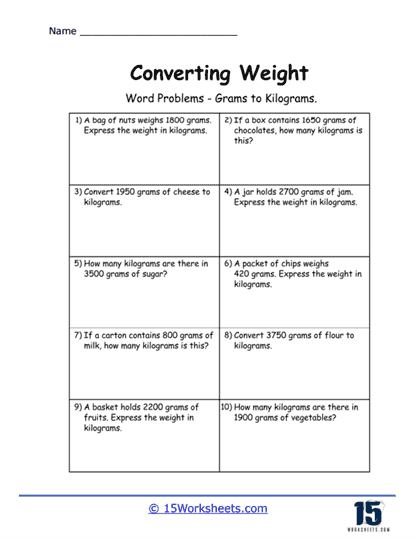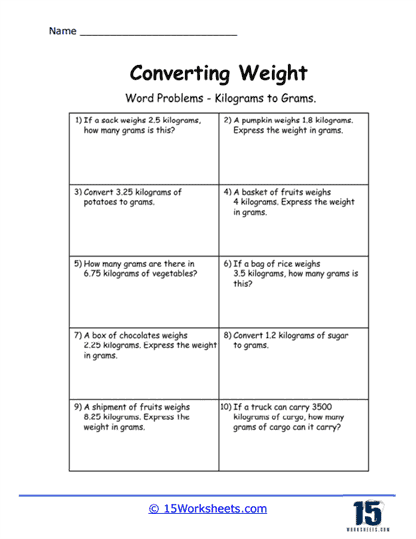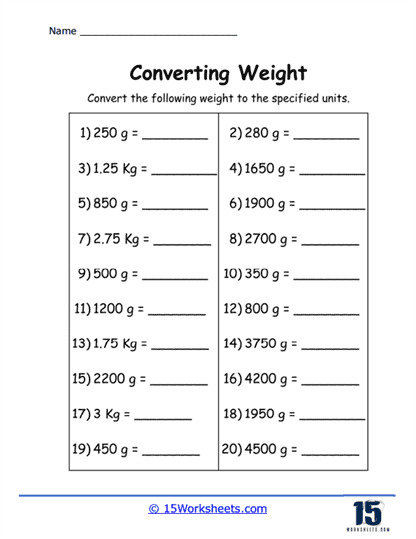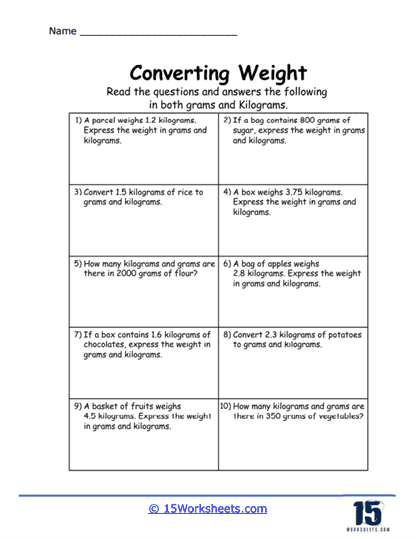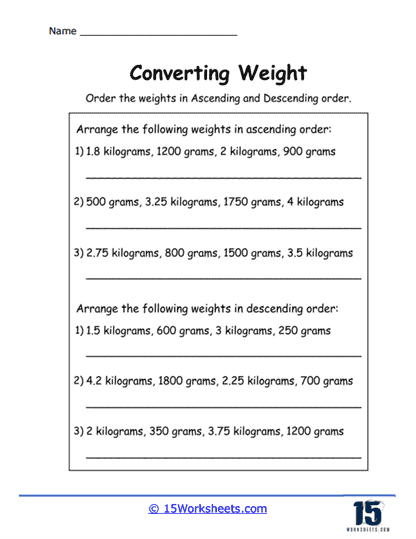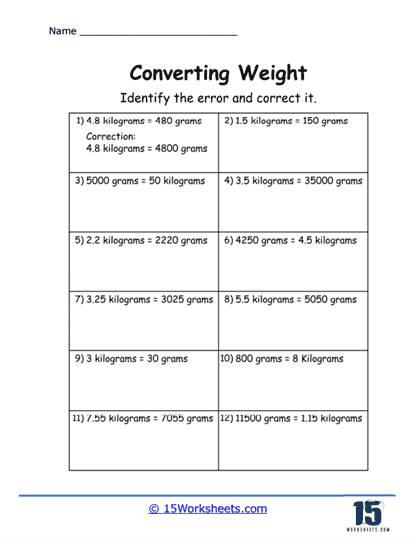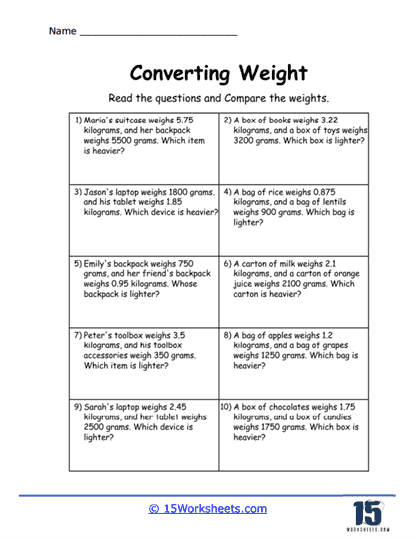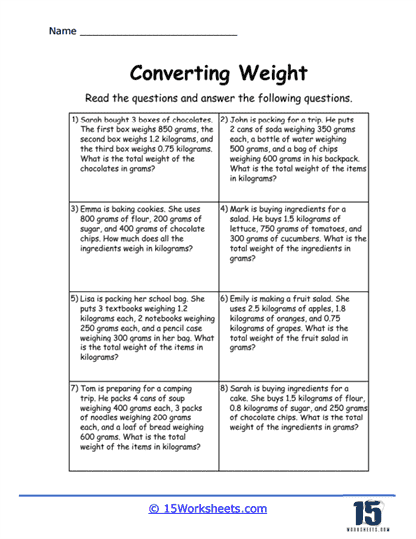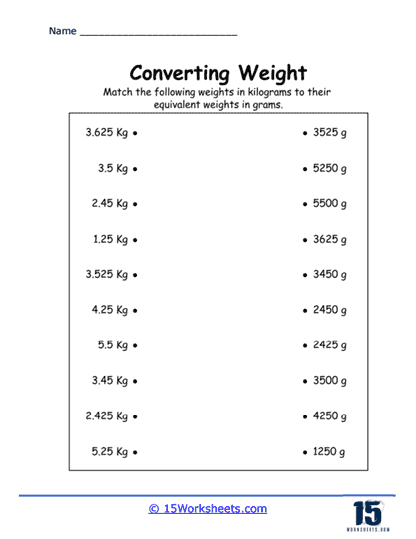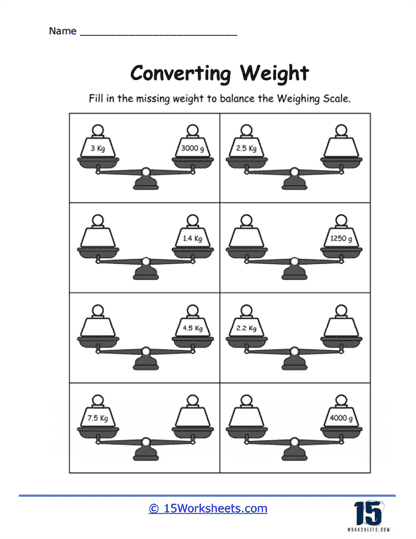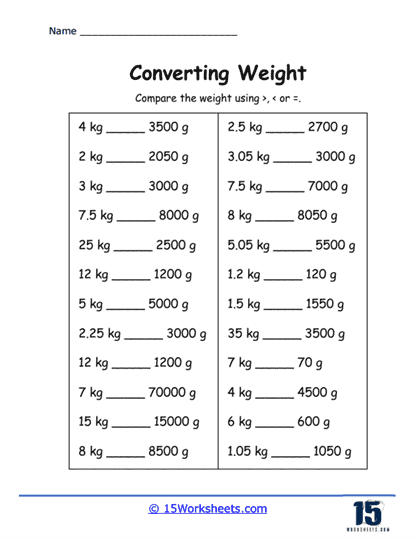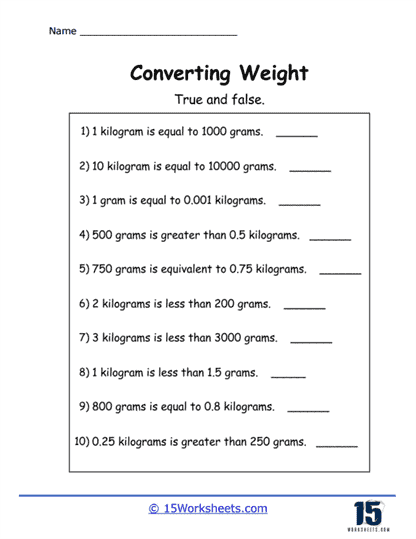Converting Metric Units of Weight Worksheets
About These 15 Worksheets
These worksheets were developed to help students understand and practice measuring and calculating weight in various units. These worksheets are crucial in building foundational skills in both the Imperial and metric systems, catering to students across a range of educational levels. By engaging with these worksheets, students learn to apply their knowledge of weight measurements to real-life contexts, perform conversions between different units, and solve complex problems that involve weight.
From basic identification to complex real-life application problems, these worksheets prepare students not only to excel academically but also to apply their skills in everyday tasks, making them practical, valuable educational resources in the study of measurement.
Understanding Units of Weight
Before delving into the types of exercises found on these worksheets, it is important to understand the common units of weight used in measurement:
Metric System – The metric system uses grams (g) as the base unit, with larger and smaller weights measured in kilograms (kg) and milligrams (mg) respectively. Kilograms are commonly used for items that can be lifted by people, like groceries, while grams might be used for lighter items, such as ingredients in cooking.
Imperial System – In the Imperial system, weights are primarily measured in pounds (lbs) and ounces (oz). One pound is equal to 16 ounces. This system is frequently used in the United States for body weight, cooking ingredients, and many other applications.
Types of Exercises
Basic Identification – These exercises involve identifying and matching objects with their approximate weights. For younger students, this could involve pairing everyday items with pictorial representations of scales showing different weights. Such exercises help students begin to visualize and estimate weight, an essential skill for practical measurement.
Conversion Exercises – These types of exercises are vital for teaching students how to navigate between different units within the same system or across different systems. These might include:
Simple Conversions – Converting grams to kilograms or ounces to pounds by using multiplication or division.
Cross-System Conversions – Converting weights from the metric system to the Imperial system, such as converting kilograms to pounds, requiring students to use specific conversion constants.
Word Problems – Word problems contextualize weight in real-life scenarios, making the math more engaging and applicable. These problems might involve calculating the total weight of items purchased, adjusting a recipe’s ingredients, or determining the weight needed for a balance scale to level.
Estimation – Here, students might be asked to estimate the weight of an object before actually weighing it, which helps them develop a sense of how much things weigh just by looking or, in a more tactile sense, lifting. Comparing their estimates with actual weights can be a powerful tool for understanding measurement error and refining estimation skills.
Using Scales – Some worksheets include exercises where students are asked to read different types of scales. This could be digital scales or analog balances. Understanding how to read scales accurately is crucial and helps students apply their knowledge in practical settings. These exercises require students to perform operations with weights, such as finding the total weight of a basket of fruit or the difference in weight between two pets. Such tasks enhance numerical literacy and are useful in everyday life. More advanced worksheets may involve tasks like calculating how many 250 gram packets can be made from 10 kilograms of flour, or how many ounces are in six pounds. These exercises are excellent for reinforcing concepts of multiplication and division within the context of weight.
Graphical Representation – Some units of weight worksheets incorporate graphing exercises, where students might graph the weights of classmates or a set of objects to understand distributions and averages. These activities help students interpret and present data effectively. These tasks are designed to encourage students to apply their measurement skills in real-world contexts, such as planning a meal for a family or packing for a trip where luggage weight is limited. They teach planning and foresight, along with measurement skills.
What is Weight?
Weight, in the context of measurement, refers to the force exerted by gravity on an object. It is a physical property that quantifies the gravitational force between an object and the Earth or another celestial body. Weight is distinct from mass, which is a measure of the amount of matter in an object. While mass remains constant regardless of location, weight can vary based on the strength of the gravitational field in which it is measured.
Units of Weight
The measurement of weight is typically conducted using units from either the metric system or the Imperial system, each serving different regions and purposes around the world.
Metric System Units
Gram (g) – The gram is the base unit of weight in the metric system, commonly used for small quantities such as groceries or ingredients in cooking.
Kilogram (kg) – One kilogram equals 1,000 grams. It is the standard unit for measuring body weight and is widely used in science, industry, and everyday life.
Milligram (mg) – One milligram equals one thousandth of a gram. It is used for very small measurements, such as doses of medication or the mass of small particles.
Ton (t) – Also known as a metric ton, one ton equals 1,000 kilograms. It is used for very large quantities, such as weights of vehicles or commodities like grain and other bulk goods.
Imperial System Units
Ounce (oz.) – Used for smaller quantities, particularly in cooking and postal services.
Pound (lb.) – One pound equals 16 ounces. Pounds are commonly used in the United States for body weight, as well as for packaging and food products.
Stone – Used primarily in the UK, one stone equals 14 pounds. It is commonly used to express human body weight.
Tonne (also known as the short ton) – One ton equals 2,000 pounds and is used predominantly in the United States for measuring things like shipping weights or raw materials.
Applications of Weight Units in the Real World
Groceries and Cooking – In groceries and cooking, units of weight are crucial for buying and selling produce, meats, and other items, where price is often based on weight. Recipes require precise measurements of ingredients in grams or ounces to ensure flavor consistency and successful culinary outcomes. Bakers especially rely on weight measurements for flour, sugar, and other components to achieve the correct texture and rise in baked goods. Accurate weighing helps manage food portions and dietary requirements, making it essential for both home cooking and professional culinary settings.
Personal Health – In personal health, monitoring weight using kilograms or pounds is integral to assessing wellness and managing conditions such as obesity or underweight. Regular weight check-ups help doctors adjust medical treatments and provide dietary recommendations. Body mass index (BMI) calculations, which involve weight and height measurements, are used to categorize weight status and assess risk factors for diseases. Weight tracking is also crucial in fitness programs, where it helps in setting goals and measuring progress.
Commercial and Industrial
Commerce – Units of weight in commerce are essential for determining the price of goods sold by weight, such as meat, vegetables, and bulk items. Accurate weight measurements ensure fairness in trade and compliance with legal standards, which can vary by region. In retail, weight impacts shipping costs and logistics, influencing overall pricing strategies and market competitiveness. Weight data is also critical in inventory management, helping businesses maintain stock levels and plan purchases efficiently.
Manufacturing – In manufacturing, precise weight measurements ensure that products meet quality and safety standards, crucial in industries like pharmaceuticals and automotive manufacturing. Weighing raw materials and components helps in maintaining consistency in production and managing costs effectively. Automated systems often use weight to monitor and adjust inputs and outputs during manufacturing processes, optimizing efficiency. Additionally, understanding the weight of finished products is essential for packaging, shipping, and compliance with industry regulations.
Science and Technology
Scientific Research – Units of weight are fundamental in scientific research for conducting accurate experiments and reporting reliable data. In chemistry and biology, the precise weighing of chemicals and biological samples can determine the success of experimental outcomes. Weight measurements are also crucial in physics to study properties like mass distribution and gravitational effects. Research involving animal studies often requires meticulous weight monitoring to ensure proper dosing of treatments and to monitor health and growth.
Engineering – In engineering, weight measurements are critical for designing structures and machinery that can withstand operational stresses and environmental factors. Accurate weight distribution calculations are necessary for the stability and safety of buildings, bridges, and other infrastructures. Engineers use weight data to optimize material usage, ensuring economic efficiency while meeting strength and durability requirements. In automotive engineering, weight impacts vehicle performance, fuel efficiency, and emissions, guiding design choices.
Transportation
Shipping and Logistics – Accurate weight measurements are crucial in shipping and logistics to optimize the loading of cargo, ensuring that vehicles, such as trucks and ships, are safely within their carrying capacity. Weight data helps in planning the best transportation routes and modes, based on cost and time efficiency. Compliance with legal weight limits is essential to avoid penalties and maintain road safety. In logistics, weight directly affects shipping costs, influencing both pricing strategies and customer satisfaction.
Aerospace – In aerospace transportation, precise weight measurement is critical for balancing aircraft to ensure safe and efficient flight operations. Weight calculations are used to determine fuel requirements, which in turn influence the range and payload capacity of the aircraft. Managing the weight of spacecraft is also crucial for achieving the necessary thrust to escape Earth’s gravity. Engineers continually seek ways to reduce weight in order to maximize payload efficiency and reduce operational costs in both aviation and space exploration.
Understanding and accurately measuring weight is therefore essential for a wide range of activities, impacting everyday life, the global economy, and technological advancement. By using appropriate units of weight and understanding their applications, precise and effective communication and operations can be achieved across diverse domains.



